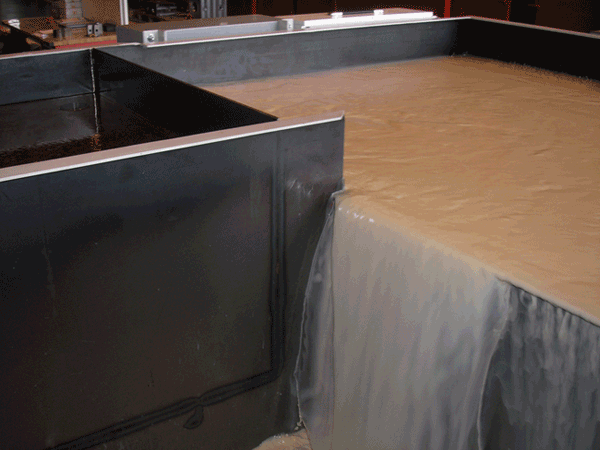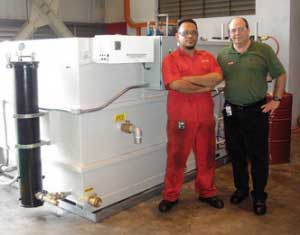Petroleum flow equipment manufacturer needs to reduce the cost of purchasing expensive coolants, improve the quality of existing coolant to ensure longer tool life and a quality finish of the end product.
Cameron International
Petroleum Flow Equipment Manufacturer
Cameron International is a leading provider of flow equipment products, systems and services to worldwide oil, gas and process industries. The company generates annual bookings in excess of $5 billion with more than 16,000 employees at more than 250 locations around the world.
Cameron’s Malaysia sub-sea facility manufactures valves for deep-sea wells ranging from a few hundred to thousands of feet (meters) below the surface. Specialty valves can range in size from as small as a file cabinet drawer to as large as a small vehicle. The facility’s 32 machining centers run 24/7 to keep up with demand.
Like most machine shops, Cameron is continually looking for ways to reduce the purchase of costly coolant while improving the quality of coolant to ensure longer tool life and a quality finish of the end product.
“We were experiencing excessive coolant usage due to heavy tramp oils at our machining centers,” said Chew Siew-Ling, Project Operations Manager at Cameron’s Malaysia plant.
To compound the issue, the warm and very humid climate in Malaysia – average of 80° F (27° C) and 80 percent humidity year-round – is a perfect environment for breeding bacteria that is quick to spoil expensive coolant.
“Bacteria present in the coolant was causing it to become rancid in a short span of time,” noted Siew-Ling.
While the operation employed several other types of filtration technologies, none offered the results Siew-Ling knew Cameron needed to combat tramp oils and bacteria. An online search led him to PRAB, who offered a depth and breadth of filtration units focused on solving industry issues. In specific, the Guardian coolant recycling system appeared to be just what Cameron needed.
 PRAB’s Guardian systems are widely used to recycle and reuse coolants from machining centers, lathes and mills, as well as oily wastewater from pressure wash stations and other applications. Standard systems can process up to 1,500 gph (5,678 lph) or 25 gpm (95 lpm). “The Guardian system recycles used coolants by filtering solid contaminants down to 5 micron clarity and coalescing free-floating and mechanically dispersed oils to less than 1 percent,” said Mark Graf, Sales Manager for PRAB.
PRAB’s Guardian systems are widely used to recycle and reuse coolants from machining centers, lathes and mills, as well as oily wastewater from pressure wash stations and other applications. Standard systems can process up to 1,500 gph (5,678 lph) or 25 gpm (95 lpm). “The Guardian system recycles used coolants by filtering solid contaminants down to 5 micron clarity and coalescing free-floating and mechanically dispersed oils to less than 1 percent,” said Mark Graf, Sales Manager for PRAB.
A continuous overflow process utilizing two, 800-gallon (3,028-liter) tanks prevents rancidity by ensuring clean fluid spills into the dirty tank. This eliminates bacteria from forming in the clean tank due to pooling. In addition, the Guardian’s continual overflow process polishes the coolant as it repeatedly passes through the liquid/solid filter as well as the coalescing filter for liquid/liquid separation.
Bacteria growth is retarded through injection of Ozone into the coolant through an automated coolant manager. Graf, who assisted with the installation, ran a test to ensure the system was inhibiting bacterial growth.
“I tested the coolant before starting up the Guardian system,” said Graf. “It was completely absent of any bacterial growth just six hours after the coolant manager had been injecting Ozone into the coolant.”
 Installation was completed with a fork-lift truck to position the unit. Plant-supplied electrical, air (40 psi) and a water source for automatic coolant make-up were the only utilities needed.
Installation was completed with a fork-lift truck to position the unit. Plant-supplied electrical, air (40 psi) and a water source for automatic coolant make-up were the only utilities needed.
Cameron initially installed the Guardian system as a standalone unit. As such, a worker transports coolant to and from the Guardian system for several of the facility’s machining centers. In the future, the facility will integrate the Guardian unit into a plant-wide coolant system that will include overhead piping for on-demand delivery coolant that will keep the concentration in balance and at the proper fill level for each machine.
“We’re looking forward to a system payback in a relatively short period of time by reducing new fluid purchases up to 75 percent while reducing hazardous waste disposal by up to 90 percent,” said Siew-Ling. “We’re also gaining efficiencies in time spent making up coolant lost due to evaporation or drag out with a properly proportioned mix from the automated make-up system.” Typical payback of a Guardian coolant recycling system is between six and nine months.